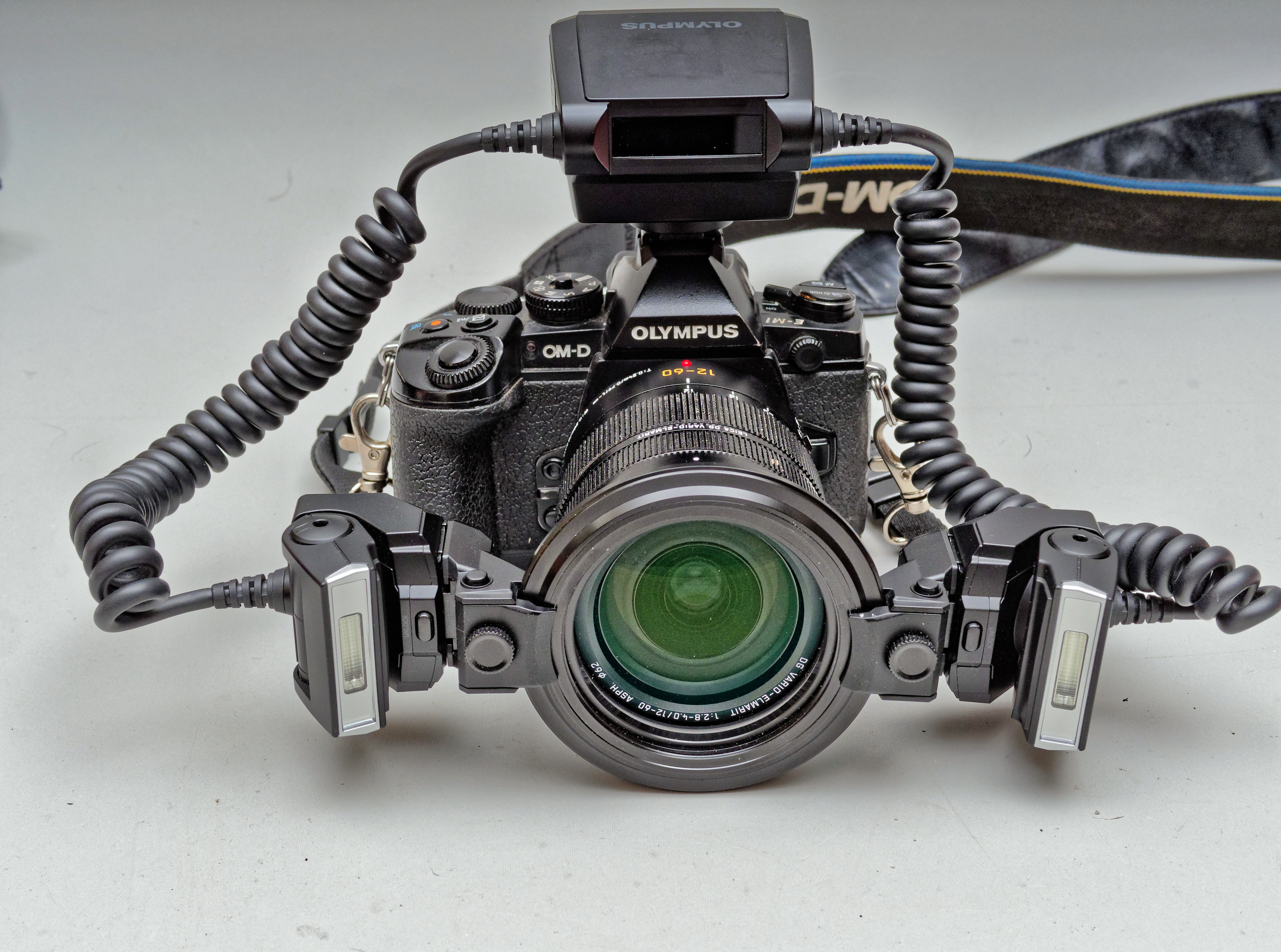
| Greg's flash units |
| Greg's photography pages |
| Greg's photo albums |
| Greg's photos |
| Greg's photo index |

|
|
|

|
|
|
I have a large number of electronic flash units, some of which are complicated enough to require making some notes. There's an overview of all of them below. The current flash units are:
This is a conventional on-camera flash. More details here.

This is a ring flash mounted on the filter thread of the camera. It normally functions as a slave flash. The master flash can be very small, like the toy units that Olympus supplied with the cameras. I've had difficulty communicating with the unit in the past, and I think that much depends on the camera settings. Watch this space.


|
|||||||||||||||||||||||
This is really two toy flash units mounted on a ring, emulating a ring flash. Here it is between the flashes for two Olympus cameras:

|
||||||||||||||||||||||||
It's the most expensive unit I have ever bought, even second-hand, and it's incredibly irritating to use. It also has a guide number of only 6.5, actually less than the guide numbers of the toy flashes.
More discussion here.

|
|||||||||||||||||||||||
The “Viltrox JY-670 Macro Ring Lite” is a fully manual ring flash. It's relatively easy to use, but only with a flash exposure meter, and I still use it when the expensive units are too much pain. More discussion here.

|
|||||||||||||||||||||||
This was a very cheap ring “flash” that emulates a flash, though it can also provide constant light. As a flash it's useless, but the constant light is good for focus stacking.
Over the years, I have had these units:
The first was a Kakonet, about which I have no further information. I appear to have got rid of it some time in December 1965.
Then on 17 August 1966 I bought a Sunpak 7d, serial number 309844. I modified this one to be able to use a smaller condenser, only 16 μF—in those days the power output was not regulated, and the smaller condenser was useful for close-ups. With the small condenser recycle time was under a second.
On 24 October 1967 I bought a second-hand Mecablitz 300, an enormous, old shoulder-pack job:

I'm not sure why I even wanted it, though it seems that it had a guide number of 46 with the reflector in “normal” position, making it the most powerful portable flash unit I have ever had. But it was clumsy, and I never used it much.
Round 1980 I bought a mecablitz 40 CT 4. I still have this unit. Despite its age, it has a power output comparable with the most powerful of modern flash units. The 40 is an indication of the guide number, but it's at a relatively wide angle setting. One of the issues with this flash is that the contact voltage is 150 V, enough to damage modern digital cameras.
On 9 October 2008 I got a studio flash setup with two 110 J (“Ws”) flashes, umbrellas and stands.
On 12 May 2009 I received a mecablitz 58 AF-1 O digital, which understands the Olympus/Panasonic/Leica flash protocol. Metz seems to have disowned this unit: all that remains on their web site is the firmware download page.
This unit has a guide number specified as 58. That looks a lot more than the 40 of the 40 CT 4, but it's measured at “105 mm”, a silly way to refer to 52.5 (!) mm in the Four Thirds format for which it is intended. At “50 mm” the guide number drops to 42, and at 35 mm it drops to only 35, less than the 40 CT 4.
In January 2013 the flash tube exploded. Repair quotes were a minimum of half the new price, so I bought a new tube and tried to repair it myself. What a disaster! I got most of the way and couldn't get it back together again. I haven't given up, but it's on the back burner.
On 9 December 2009 I got a clip-on ring flash adapter for my new mecablitz:

|
|||||||||||||||||||||||

|
|||||||||||||||||||||||
I was quite happy with it at the time, but it was dimensioned for the E-30, and after getting the E-M1 the ring was positioned too low. In the meantime I've decided that it was just too clumsy, so I won't replace it.
My Olympus OM-D E-M1 camera came with a bundled “flash”, the FL-LM2 with a guide number of 7! It's pretty useless.
To make up for the FL-LM2, I bought a Meike MK-300, a cheap flash unit which understands the Olympus/Panasonic/Leica protocol. It has the advantage of being a lot smaller than the mecablitz:

|
|||||||||||||||||||||||

|
|||||||||||||||||||||||
It has a claimed guide number of 32 (and no focal length adjustments), though I have my doubts. Still, for many things it does the trick. It has proved unreliable, unfortunately: sometimes it doesn't trigger. I have a suspicion that the trigger voltage is too low to work reliably with my cameras.
Despite my reservations, on 27 March 2014 I got a new mecablitz 58 AF-2, effectively the same flash with a few new features that I don't need. If I get the 58 AF-I repaired, they can communicate with each other.
Yvonne's new Olympus E-PM2 came with another toy flash, this time called FL-LM1. It has the same low guide number of 7 as the FL-LM2, and the other specifications are also identical. Possibly it's just the same flash with different cosmetics to match the appearance of the camera.
The Olympus OM-D E-M1 Mark II came with another toy flash, the FL-LM3, this time not quite as much a toy: it can do a few additional things that the older ones can't. It also has a guide number of 9.
On 28 October 2014 I received a “Viltrox JY-670 Macro Ring Lite”. I'm still not sure whether that means “light” as in flash, or “light” as in “not the full quantity”.
On 17 March 2018 I received a used Olympus STF-8 macro flash unit with two flash heads very similar in appearance to the toys delivered with recent cameras. They have the lowest guide number yet: 6.5. It's a nightmare to use, and for some reason it doesn't work with Olympus' focus stacking.
On 21 August 2019 I took delivery of a mecablitz 15 MS-1 ring flash unit, my latest attempt at macro flashes. It's a slave flash, which put me off, but it's so much easier to use than the Olympus STF-8.
Yvonne's Olympus OM-D E-M5 Mark III came with yet another toy flash, the FL-LM3.
On 24 September 2020, with the Nikon FM2, I received a yet another mecablitz, a 45 CL-1, also the largest since my old 1950s mecablitz 300.
| Greg's home page | Greg's diary | Greg's photos | Copyright |